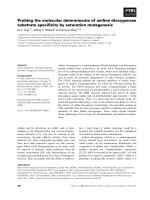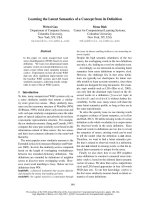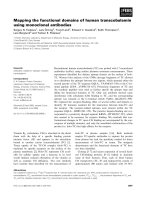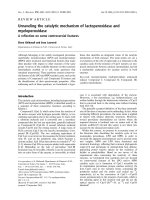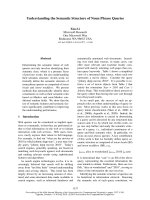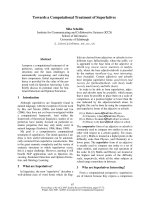Báo cáo khoa học: "Towards the Unsupervised Acquisition of Discourse Relations" pptx
Bạn đang xem bản rút gọn của tài liệu. Xem và tải ngay bản đầy đủ của tài liệu tại đây (119.04 KB, 5 trang )
Proceedings of the 50th Annual Meeting of the Association for Computational Linguistics, pages 213–217,
Jeju, Republic of Korea, 8-14 July 2012.
c
2012 Association for Computational Linguistics
Towards the Unsupervised Acquisition of Discourse Relations
Christian Chiarcos
Information Sciences Institute
University of Southern California
4676 Admiralty Way, Marina del Rey, CA 90292
Abstract
This paper describes a novel approach towards
the empirical approximation of discourse re-
lations between different utterances in texts.
Following the idea that every pair of events
comes with preferences regarding the range
and frequency of discourse relations connect-
ing both parts, the paper investigates whether
these preferences are manifested in the distri-
bution of relation words (that serve to signal
these relations).
Experiments on two large-scale English web
corpora show that significant correlations be-
tween pairs of adjacent events and relation
words exist, that they are reproducible on dif-
ferent data sets, and for three relation words,
that their distribution corresponds to theory-
based assumptions.
1 Motivation
Texts are not merely accumulations of isolated ut-
terances, but the arrangement of utterances conveys
meaning; human text understanding can thus be de-
scribed as a process to recover the global structure
of texts and the relations linking its different parts
(Vallduv
´
ı 1992; Gernsbacher et al. 2004). To capture
these aspects of meaning in NLP, it is necessary to
develop operationalizable theories, and, within a su-
pervised approach, large amounts of annotated train-
ing data. To facilitate manual annotation, weakly
supervised or unsupervised techniques can be ap-
plied as preprocessing step for semimanual anno-
tation, and this is part of the motivation of the ap-
proach described here.
Discourse relations involve different aspects of
meaning. This may include factual knowledge
about the connected discourse segments (a ‘subject-
matter’ relation, e.g., if one utterance represents
the cause for another, Mann and Thompson 1988,
p.257), argumentative purposes (a ‘presentational’
relation, e.g., one utterance motivates the reader to
accept a claim formulated in another utterance, ibid.,
p.257), or relations between entities mentioned in
the connected discourse segments (anaphoric rela-
tions, Webber et al. 2003). Discourse relations can
be indicated explicitly by optional cues, e.g., ad-
verbials (e.g., however), conjunctions (e.g., but), or
complex phrases (e.g., in contrast to what Peter said
a minute ago). Here, these cues are referred to as
relation words.
Assuming that relation words are associated with
specific discourse relations (Knott and Dale 1994;
Prasad et al. 2008), the distribution of relation words
found between two (types of) events can yield in-
sights into the range of discourse relations possi-
ble at this occasion and their respective likeliness.
For this purpose, this paper proposes a background
knowledge base (BKB) that hosts pairs of events
(here heuristically represented by verbs) along with
distributional profiles for relation words. The pri-
mary data structure of the BKB is a triple where
one event (type) is connected with a particular re-
lation word to another event (type). Triples are fur-
ther augmented with a frequency score (expressing
the likelihood of the triple to be observed), a sig-
nificance score (see below), and a correlation score
(indicating whether a pair of events has a positive or
negative correlation with a particular relation word).
213
Triples can be easily acquired from automatically
parsed corpora. While the relation word is usually
part of the utterance that represents the source of
the relation, determining the appropriate target (an-
tecedent) of the relation may be difficult to achieve.
As a heuristic, an adjacency preference is adopted,
i.e., the target is identified with the main event of the
preceding utterance.
1
The BKB can be constructed
from a sufficiently large corpus as follows:
• identify event types and relation words
• for every utterance
– create a candidate triple consisting of the
event type of the utterance, the relation
word, and the event type of the preceding
utterance.
– add the candidate triple to the BKB, if it
found in the BKB, increase its score by (or
initialize it with) 1,
• perform a pruning on all candidate triples, cal-
culate significance and correlation scores
Pruning uses statistical significance tests to evalu-
ate whether the relative frequency of a relation word
for a pair of events is significantly higher or lower
than the relative frequency of the relation word in
the entire corpus. Assuming that incorrect candi-
date triples (i.e., where the factual target of the rela-
tion was non-adjacent) are equally distributed, they
should be filtered out by the significance tests.
The goal of this paper is to evaluate the validity of
this approach.
2 Experimental Setup
By generalizing over multiple occurrences of the
same events (or, more precisely, event types), one
can identify preferences of event pairs for one or
several relation words. These preferences capture
context-invariant characteristics of pairs of events
and are thus to considered to reflect a semantic pre-
disposition for a particular discourse relation.
Formally, an event is the semantic representa-
tion of the meaning conveyed in the utterance. We
1
Relations between non-adjacent utterances are constrained
by the structure of discourse (Webber 1991), and thus less likely
than relations between adjacent utterances.
assume that the same event can reoccur in differ-
ent contexts, we are thus studying relations be-
tween types of events. For the experiment described
here, events are heuristically identified with the main
predicates of a sentence, i.e., non-auxiliar, non-
causative, non-modal verbal lexemes that serve as
heads of main clauses.
The primary data structure of the approach de-
scribed here is a triple consisting of a source event, a
relation word and a target (antecedent) event. These
triples are harvested from large syntactically anno-
tated corpora. For intersentential relations, the tar-
get is identified with the event of the immediately
preceding main clause. These extraction preferences
are heuristic approximations, and thus, an additional
pruning step is necessary.
For this purpose, statistical significance tests are
adopted (χ
2
for triples of frequent events and re-
lation words, t-test for rare events and/or relation
words) that compare the relative frequency of a rela-
tion word given a pair of events with the relative fre-
quency of the relation word in the entire corpus. All
results with p ≥ .05 are excluded, i.e., only triples
are preserved for which the observed positive or neg-
ative correlation between a pair of events and a re-
lation word is not due to chance with at least 95%
probability. Assuming an even distribution of incor-
rect target events, this should rule these out. Ad-
ditionally, it also serves as a means of evaluation.
Using statistical significance tests as pruning crite-
rion entails that all triples eventually confirmed are
statistically significant.
2
This setup requires immense amounts of data: We
are dealing with several thousand events (theoreti-
cally, the total number of verbs of a language). The
chance probability for two events to occur in adja-
cent position is thus far below 10
−6
, and it decreases
further if the likelihood of a relation word is taken
into consideration. All things being equal, we thus
need millions of sentences to create the BKB.
Here, two large-scale corpora of English are em-
ployed, PukWaC and Wackypedia EN (Baroni et al.
2009). PukWaC is a 2G-token web corpus of British
English crawled from the uk domain (Ferraresi et al.
2
Subsequent studies may employ less rigid pruning criteria.
For the purpose of the current paper, however, the statistical sig-
nificance of all extracted triples serves as an criterion to evaluate
methodological validity.
214
2008), and parsed with MaltParser (Nivre et al.
2006). It is distributed in 5 parts; Only PukWaC-
1 to PukWaC-4 were considered here, constitut-
ing 82.2% (72.5M sentences) of the entire corpus,
PukWaC-5 is left untouched for forthcoming evalu-
ation experiments. Wackypedia EN is a 0.8G-token
dump of the English Wikipedia, annotated with the
same tools. It is distributed in 4 different files; the
last portion was left untouched for forthcoming eval-
uation experiments. The portion analyzed here com-
prises 33.2M sentences, 75.9% of the corpus.
The extraction of events in these corpora uses
simple patterns that combine dependency informa-
tion and part-of-speech tags to retrieve the main
verbs and store their lemmata as event types. The
target (antecedent) event was identified with the last
main event of the preceding sentence. As relation
words, only sentence-initial children of the source
event that were annotated as adverbial modifiers,
verb modifiers or conjunctions were considered.
3 Evaluation
To evaluate the validity of the approach, three funda-
mental questions need to be addressed: significance
(are there significant correlations between pairs of
events and relation words ?), reproducibility (can
these correlations confirmed on independent data
sets ?), and interpretability (can these correlations
be interpreted in terms of theoretically-defined dis-
course relations ?).
3.1 Significance and Reproducibility
Significance tests are part of the pruning stage of the
algorithm. Therefore, the number of triples eventu-
ally retrieved confirms the existence of statistically
significant correlations between pairs of events and
relation words. The left column of Tab. 1 shows
the number of triples obtained from PukWaC sub-
corpora of different size.
For reproducibility, compare the triples identified
with Wackypedia EN and PukWaC subcorpora of
different size: Table 1 shows the number of triples
found in both Wackypedia EN and PukWaC, and the
agreement between both resources. For two triples
involving the same events (event types) and the same
relation word, agreement means that the relation
word shows either positive or negative correlation
PukWaC (sub)corpus Wackypedia EN triples
sentences triples common agreeing %
1.2M 74 20 12 60.0
4.8M 832 177 132 75.5
19.2M 7,342 938 809 86.3
38.4M 20,106 1,783 1,596 89.9
72.5M 46,680 2,643 2,393 90.5
Table 1: Agreement with respect to positive or nega-
tive correlation of event pairs and relation words be-
tween Wackypedia EN and PukWaC subcorpora of dif-
ferent size
PukWaC triples agreement (%)
total vs. H vs. T vs. H vs. T
B: but 11,042 6,805 1,525 97.7 62.2
H: however 7,251 1,413 66.9
T: then 1,791
Table 2: Agreement between but (B), however (H) and
then (T) on PukWaC
in both corpora, disagreement means positive corre-
lation in one corpus and negative correlation in the
other.
Table 1 confirms that results obtained on one re-
source can be reproduced on another. This indi-
cates that triples indeed capture context-invariant,
and hence, semantic, characteristics of the relation
between events. The data also indicates that repro-
ducibility increases with the size of corpora from
which a BKB is built.
3.2 Interpretability
Any theory of discourse relations would predict that
relation words with similar function should have
similar distributions, whereas one would expect dif-
ferent distributions for functionally unrelated rela-
tion words. These expectations are tested here for
three of the most frequent relation words found in
the corpora, i.e., but, then and however. But and
however can be grouped together under a general-
ized notion of contrast (Knott and Dale 1994; Prasad
et al. 2008); then, on the other hand, indicates a tem-
poral and/or causal relation.
Table 2 confirms the expectation that event pairs
that are correlated with but tend to show the same
correlation with however, but not with then.
215
4 Discussion and Outlook
This paper described a novel approach towards the
unsupervised acquisition of discourse relations, with
encouraging preliminary results: Large collections
of parsed text are used to assess distributional pro-
files of relation words that indicate discourse re-
lations that are possible between specific types of
events; on this basis, a background knowledge base
(BKB) was created that can be used to predict an ap-
propriate discourse marker to connect two utterances
with no overt relation word.
This information can be used, for example, to fa-
cilitate the semiautomated annotation of discourse
relations, by pointing out the ‘default’ relation word
for a given pair of events. Similarly, Zhou et al.
(2010) used a language model to predict discourse
markers for implicitly realized discourse relations.
As opposed to this shallow, n-gram-based approach,
here, the internal structure of utterances is exploited:
based on semantic considerations, syntactic patterns
have been devised that extract triples of event pairs
and relation words. The resulting BKB provides a
distributional approximation of the discourse rela-
tions that can hold between two specific event types.
Both approaches exploit complementary sources of
knowledge, and may be combined with each other
to achieve a more precise prediction of implicit dis-
course connectives.
The validity of the approach was evaluated with
respect to three evaluation criteria: The extracted as-
sociations between relation words and event pairs
could be shown to be statistically significant, and
to be reproducible on other corpora; for three
highly frequent relation words, theoretical predic-
tions about their relative distribution could be con-
firmed, indicating their interpretability in terms of
presupposed taxonomies of discourse relations.
Another prospective field of application can be
seen in NLP applications, where selection prefer-
ences for relation words may serve as a cheap re-
placement for full-fledged discourse parsing. In the
Natural Language Understanding domain, the BKB
may help to disambiguate or to identify discourse
relations between different events; in the context of
Machine Translation, it may represent a factor guid-
ing the insertion of relation words, a task that has
been found to be problematic for languages that dif-
fer in their inventory and usage of discourse mark-
ers, e.g., German and English (Stede and Schmitz
2000). The approach is language-independent (ex-
cept for the syntactic extraction patterns), and it does
not require manually annotated data. It would thus
be easy to create background knowledge bases with
relation words for other languages or specific do-
mains – given a sufficient amount of textual data.
Related research includes, for example, the un-
supervised recognition of causal and temporal rela-
tionships, as required, for example, for the recog-
nition of textual entailment. Riaz and Girju (2010)
exploit distributional information about pairs of ut-
terances. Unlike approach described here, they are
not restricted to adjacent utterances, and do not rely
on explicit and recurrent relation words. Their ap-
proach can thus be applied to comparably small
data sets. However, they are restricted to a spe-
cific type of relations whereas here the entire band-
width of discourse relations that are explicitly real-
ized in a language are covered. Prospectively, both
approaches could be combined to compensate their
respective weaknesses.
Similar observations can be made with respect to
Chambers and Jurafsky (2009) and Kasch and Oates
(2010), who also study a single discourse relation
(narration), and are thus more limited in scope than
the approach described here. However, as their ap-
proach extends beyond pairs of events to complex
event chains, it seems that both approaches provide
complementary types of information and their re-
sults could also be combined in a fruitful way to
achieve a more detailed assessment of discourse re-
lations.
The goal of this paper was to evaluate the meth-
dological validity of the approach. It thus represents
the basis for further experiments, e.g., with respect
to the enrichment the BKB with information pro-
vided by Riaz and Girju (2010), Chambers and Ju-
rafsky (2009) and Kasch and Oates (2010). Other di-
rections of subsequent research may include address
more elaborate models of events, and the investiga-
tion of the relationship between relation words and
taxonomies of discourse relations.
216
Acknowledgments
This work was supported by a fellowship within
the Postdoc program of the German Academic Ex-
change Service (DAAD). Initial experiments were
conducted at the Collaborative Research Center
(SFB) 632 “Information Structure” at the Univer-
sity of Potsdam, Germany. I would also like to
thank three anonymous reviewers for valuable com-
ments and feedback, as well as Manfred Stede and
Ed Hovy whose work on discourse relations on the
one hand and proposition stores on the other hand
have been the main inspiration for this paper.
References
M. Baroni, S. Bernardini, A. Ferraresi, and
E. Zanchetta. The wacky wide web: a collec-
tion of very large linguistically processed web-
crawled corpora. Language Resources and Eval-
uation, 43(3):209–226, 2009.
N. Chambers and D. Jurafsky. Unsupervised learn-
ing of narrative schemas and their participants. In
Proceedings of the Joint Conference of the 47th
Annual Meeting of the ACL and the 4th Inter-
national Joint Conference on Natural Language
Processing of the AFNLP: Volume 2-Volume 2,
pages 602–610. Association for Computational
Linguistics, 2009.
A. Ferraresi, E. Zanchetta, M. Baroni, and S. Bernar-
dini. Introducing and evaluating ukwac, a very
large web-derived corpus of english. In Proceed-
ings of the 4th Web as Corpus Workshop (WAC-4)
Can we beat Google, pages 47–54, 2008.
Morton Ann Gernsbacher, Rachel R. W. Robertson,
Paola Palladino, and Necia K. Werner. Manag-
ing mental representations during narrative com-
prehension. Discourse Processes, 37(2):145–164,
2004.
N. Kasch and T. Oates. Mining script-like struc-
tures from the web. In Proceedings of the NAACL
HLT 2010 First International Workshop on For-
malisms and Methodology for Learning by Read-
ing, pages 34–42. Association for Computational
Linguistics, 2010.
A. Knott and R. Dale. Using linguistic phenomena
to motivate a set of coherence relations. Discourse
processes, 18(1):35–62, 1994.
J. van Kuppevelt and R. Smith, editors. Current Di-
rections in Discourse and Dialogue. Kluwer, Dor-
drecht, 2003.
William C. Mann and Sandra A. Thompson. Rhetor-
ical Structure Theory: Toward a functional theory
of text organization. Text, 8(3):243–281, 1988.
J. Nivre, J. Hall, and J. Nilsson. Maltparser: A
data-driven parser-generator for dependency pars-
ing. In Proc. of LREC, pages 2216–2219. Cite-
seer, 2006.
R. Prasad, N. Dinesh, A. Lee, E. Miltsakaki,
L. Robaldo, A. Joshi, and B. Webber. The penn
discourse treebank 2.0. In Proc. 6th International
Conference on Language Resources and Evalua-
tion (LREC 2008), Marrakech, Morocco, 2008.
M. Riaz and R. Girju. Another look at causality:
Discovering scenario-specific contingency rela-
tionships with no supervision. In Semantic Com-
puting (ICSC), 2010 IEEE Fourth International
Conference on, pages 361–368. IEEE, 2010.
M. Stede and B. Schmitz. Discourse particles and
discourse functions. Machine translation, 15(1):
125–147, 2000.
Enric Vallduv
´
ı. The Informational Component. Gar-
land, New York, 1992.
Bonnie L. Webber. Structure and ostension in the
interpretation of discourse deixis. Natural Lan-
guage and Cognitive Processes, 2(6):107–135,
1991.
Bonnie L. Webber, Matthew Stone, Aravind K.
Joshi, and Alistair Knott. Anaphora and discourse
structure. Computational Linguistics, 4(29):545–
587, 2003.
Z M. Zhou, Y. Xu, Z Y. Niu, M. Lan, J. Su, and
C.L. Tan. Predicting discourse connectives for
implicit discourse relation recognition. In COL-
ING 2010, pages 1507–1514, Beijing, China, Au-
gust 2010.
217

